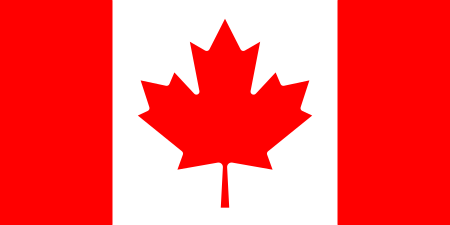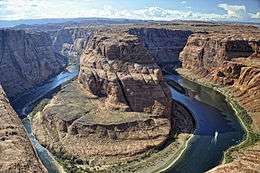Estuary of Saint Lawrence
The estuary of the Saint Lawrence in Quebec, Canada, is one of the largest estuaries in the world.[1]
| Saint Lawrence Estuary Estuaire du Saint-Laurent (in French) | |
|---|---|
Estuary of Saint-Laurent at Port-au-Saumon (Quebec). | |
| Etymology | Saint Lawrence of Rome |
| Location | |
| Country | Canada |
| Province | Quebec |
| Physical characteristics | |
| Source | Saint Lawrence River |
| • location | Lake Saint-Pierre, Trois-Rivières, Quebec, Canada |
| • coordinates | 46°16′17″N 72°38′5″W |
| Mouth | Gulf of St. Lawrence / Atlantic Ocean |
• location | Pointe-des-Monts, Quebec, Canada |
• coordinates | 49°08′N 67°14′W |
• elevation | 0 m (0 ft) |
| Discharge | |
| • location | below the Saint Lawrence River |
Situation
The estuary of the St. Lawrence River is located downstream of the St. Lawrence River and upstream of the Gulf of St. Lawrence. It refers to the place where the fresh and salt waters mix between the river and the gulf. The St. Lawrence Estuary begins at Lake Saint-Pierre[2] and ends at the widening of the shores, at the height of Pointe-des-Monts, Quebec,[3] opposite Les Méchins, Quebec. It is divided into three sections: the St. Lawrence River estuary at Île d'Orléans (Orleans Island), the middle estuary to the Saguenay Fjord, the maritime estuary to Pointe-des-Monts, Quebec.
The St. Lawrence Estuary is characterized by a saline front at the eastern tip of Île d'Orléans. The zone of contact between fresh and salt water corresponds to a region of high concentrations of suspended matter causing a zone of maximum turbidity (MTZ) of a length that can vary from 70 to 120 kilometres (43 to 75 mi), depending on the flow of the river.[4] This zone of maximum turbidity is located between Île d'Orléans (salinity greater than 0 PSU) and Île aux Coudres (salinity below 10 PSU). The mechanisms of estuarine circulation associated with this environment make it a privileged site of primary and secondary production which shelters many fish nurseries. High environmental turbidity provides shelter against predators while larvae are maintained under optimum temperature and salinity conditions.[5] Large variations in salinity and turbidity result in a wide variety of physicochemical conditions and planktonic communities on the river.
Fauna and flora
An emblematic species is the beluga (beluga whale), but many other species are present.
In a spirit of citizen science and collaborative work, a census of estuary fish is underway, with a downloadable identification guide[6]
See also


Notes
- Rossignol, Anne (1998). L’estuaire maritime et le golfe du Saint-Laurent: Carnet d’océanographie (in French). Rimouski: INRS-Oceanology & Pêches et Océans Canada. p. 12. ISBN 2-9805922-0-X.
L’estuaire du Saint-Laurent se classe parmi les plus profond et les plus grands estuaires du monde; sa largeur excède même la longueur de plusieurs estuaires.
- "0303-carte.jpg". Sustainable development, Environment and Park. Retrieved 27 November 2008.
- "Le Gîte du Phare de Pointe-des-Monts". www.pointe-des-monts.com.
- Silverberg and Sundby 1979
- Sirois and Dodson 2000, North and Houde 2001, Winkler et al., 2003
- C. Nozères, D. Archambault, P.-M.Chouinard, J. Gauthier, R. Miller, E. Parent, P. Schwab, L. Savard and J.-D. Dutil, Guide to the Identification of Marine Fish in the Estuary and Northern Gulf of St. Lawrence and Protocols for Their sampling during trawl surveys between 2004 and 2008, Regional Directorate of Science; Fisheries and Oceans Canada, Heavy Document (over 86 Mb)